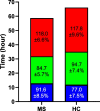The effect of a structured running exercise intervention on non-exercise physical activity and sedentary behaviour in persons with mild Multiple Sclerosis and healthy controls
- PMID: 40217416
- PMCID: PMC11960282
- DOI: 10.1186/s44167-023-00037-1
The effect of a structured running exercise intervention on non-exercise physical activity and sedentary behaviour in persons with mild Multiple Sclerosis and healthy controls
Abstract
Background: Exercise interventions fail to increase objective physical activity (PA) in persons with Multiple Sclerosis (PwMS), while they self-report higher exercise participation. This suggests that PwMS change their non-exercise PA (NEPA). We aimed to explore NEPA changes of PwMS and healthy controls (HC), and whether these constrain exercise adaptations.
Methods: Twenty-nine mildly-disabled PwMS and 26 HC completed a 10-month home-based running program. A non-randomised controlled study design was used. The primary outcome was time in different NEPA intensities (light intensity PA [LIPA] and moderate-to-vigorous intensity PA [MVPA]) and in sedentary behaviour ([SB]; total and uninterrupted SB) at baseline (T1), after 5 (T2) and 10 (T3) months of exercise. Data were averaged over days with and without exercise sessions (EX and NONEX days). Secondary outcomes included patient-reported and physical exercise adaptations (fatigue, walking mobility, blood pressure, body composition and cardiorespiratory fitness).
Results: A significant reduction in non-exercise MVPA was observed from T1 to T2 (- 113 ± 31 min/week, p < 0.01) and from T1 to T3 (- 95 ± 26 min/week, p < 0.01) in PwMS, which approximately matched the weekly exercise duration at those time points. PwMS also increased their uninterrupted SB on NONEX days compared to EX days (+ 0.7 ± 0.3 h, p < 0.01). There were no changes in MVPA or SB of HC (group × time effect MVPA: p < 0.05; group × EX day effect uninterrupted SB: p < 0.01). Secondary outcomes improved similarly in both groups and were not associated with NEPA/SB changes.
Conclusions: In contrast to HC, PwMS significantly changed their NEPA and the pattern in which they accumulated SB in response to structured exercise. This might be a necessary behavioural compensation in order to adhere to the exercise intervention and did not constrain patient-reported and physical outcomes. Future research is warranted to unravel the underlying causes and to investigate the effects on other exercise adaptations, such as cardiometabolic health. Trial registration The present study was registered (December 10, 2019) at clinicaltrials.gov as NCT04191772.
Keywords: Exercise; Exercise adaptations; Multiple Sclerosis; Non-exercise physical activity; Sedentary behaviour.
© 2023. The Author(s).
Conflict of interest statement
Declarations. Ethics approval and consent to participate: The study protocol was approved by the Medical Ethical Committee of Hasselt University (Hasselt, Belgium; CME2019/062) and the Jessa Hospital Hasselt (Belgium), was conducted in accordance with the principles of the Declaration of Helsinki (2013) and is registered at clinicaltrials.gov as NCT04191772 (December 19, 2019). Consent for publication: Not applicable. Competing interests: Author Wouter M.A. Franssen is a member of the Editorial Board of Journal of Activity, Sedentary and Sleep Behaviors. The paper was handled by another Editor and has undergone a rigorous peer review process. Author Wouter M.A. Franssen was not involved in the journal’s peer review of or decisions related to, this manuscript. All other authors report that there are no competing interests to declare.
Figures



Similar articles
-
Replacing sitting with light-intensity physical activity throughout the day versus 1 bout of vigorous-intensity exercise: similar cardiometabolic health effects in multiple sclerosis. A randomised cross-over study.Disabil Rehabil. 2023 Oct;45(20):3293-3302. doi: 10.1080/09638288.2022.2122601. Epub 2022 Oct 3. Disabil Rehabil. 2023. PMID: 36190113 Clinical Trial.
-
Comparison of patient-reported outcomes of physical activity and accelerometry in people with multiple sclerosis and ambulatory impairment: A cross-sectional study.Mult Scler Relat Disord. 2024 May;85:105532. doi: 10.1016/j.msard.2024.105532. Epub 2024 Mar 1. Mult Scler Relat Disord. 2024. PMID: 38452648
-
Associations between accelerometer-measured physical activity and sedentary behaviour with physical function among older women: a cross-sectional study.BMC Public Health. 2024 Jul 2;24(1):1754. doi: 10.1186/s12889-024-19270-7. BMC Public Health. 2024. PMID: 38956531 Free PMC article.
-
Comprehensive evaluation of accelerometer-based physical activity in persons with multiple sclerosis - The influence of disability status and its impact on walking capacity.Mult Scler Relat Disord. 2025 Jan;93:106243. doi: 10.1016/j.msard.2024.106243. Epub 2024 Dec 19. Mult Scler Relat Disord. 2025. PMID: 39729903
-
Interventions outside the workplace for reducing sedentary behaviour in adults under 60 years of age.Cochrane Database Syst Rev. 2020 Jul 17;7(7):CD012554. doi: 10.1002/14651858.CD012554.pub2. Cochrane Database Syst Rev. 2020. PMID: 32678471 Free PMC article.
References
-
- Tullman MJ. Overview of the epidemiology, diagnosis, and disease progression associated with multiple sclerosis. Am J Manag Care. 2013;19(2 Suppl):S15-20. - PubMed
-
- Noseworthy JH, Lucchinetti C, Rodriguez M, et al. Multiple sclerosis. N Engl J Med. 2000;343(13):938–52. - PubMed
-
- Asano M, Duquette P, Andersen R, et al. Exercise barriers and preferences among women and men with multiple sclerosis. Disabil Rehabil. 2013;35(5):353–61. - PubMed
-
- Macdonald E, Buchan D, Cerexhe L, et al. Accelerometer measured physical activity and sedentary time in individuals with multiple sclerosis versus age matched controls: a systematic review and meta-analysis. Mult Scler Relat Disord. 2022;9(69): 104462. - PubMed
-
- Dalgas U, Langeskov-Christensen M, Stenager E, et al. Exercise as medicine in multiple sclerosis-time for a paradigm shift: preventive, symptomatic, and disease-modifying aspects and perspectives. Curr Neurol Neurosci Rep. 2019;19(11):88. - PubMed
Associated data
Grants and funding
LinkOut - more resources
Full Text Sources
Medical
